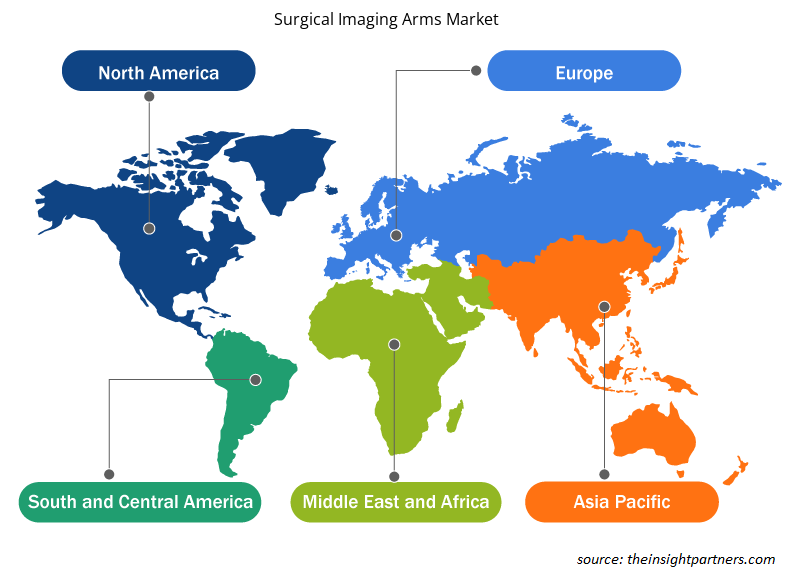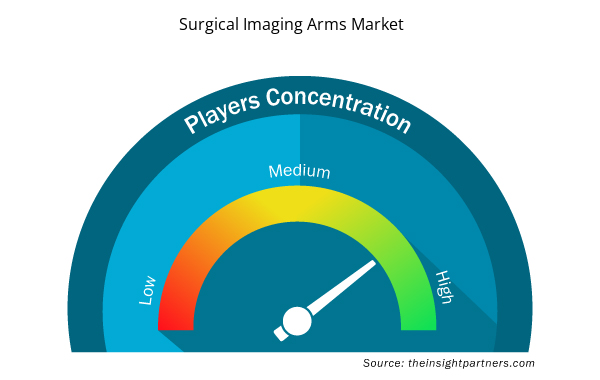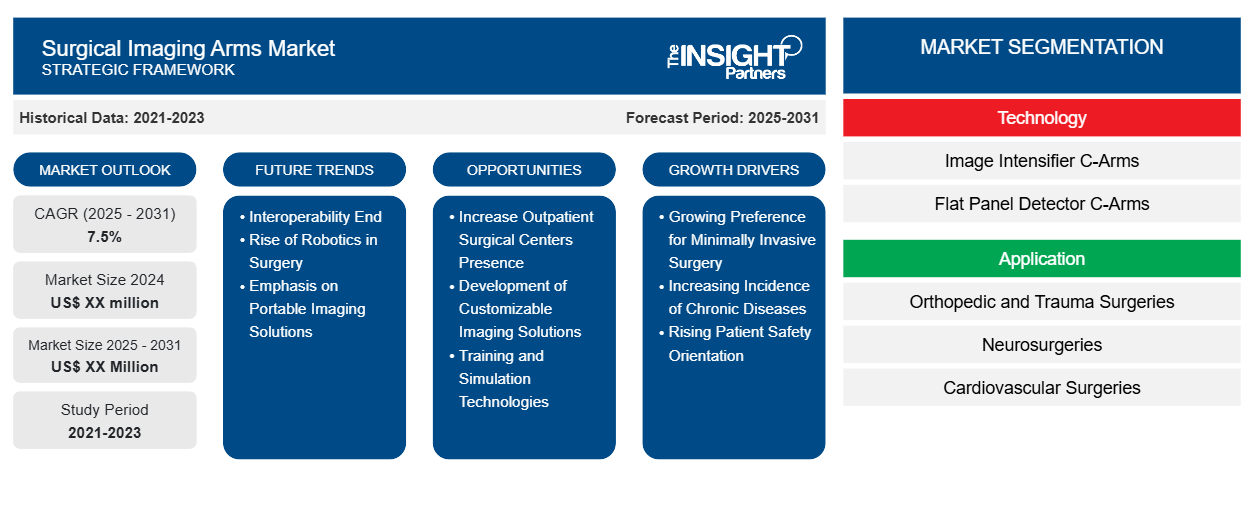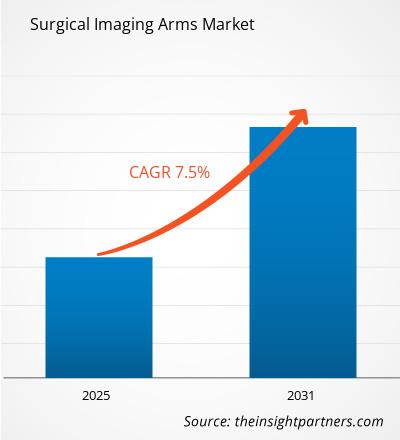Se espera que el mercado de armas de imágenes quirúrgicas registre una CAGR del 7,5 % entre 2023 y 2031, con un tamaño de mercado que se expandirá de US$ XX millones en 2023 a US$ XX millones en 2031.
El informe está segmentado por tecnología (arcos en C intensificadores de imagen, arcos en C detectores de panel plano). Además, está segmentado según la aplicación (cirugías ortopédicas y de traumatología, neurocirugías, cirugías cardiovasculares, cirugías gastrointestinales, otras aplicaciones). El análisis global se desglosa aún más a nivel regional y por países principales. El informe ofrece el valor en USD para el análisis y los segmentos anteriores.
Propósito del Informe
El informe Surgical Imaging Arms Market de The Insight Partners tiene como objetivo describir el panorama actual y el crecimiento futuro, los principales factores impulsores, los desafíos y las oportunidades. Esto proporcionará información a diversas partes interesadas del negocio, como:
- Proveedores/fabricantes de tecnología: Para comprender la dinámica cambiante del mercado y conocer las oportunidades potenciales de crecimiento, lo que les permitirá tomar decisiones estratégicas informadas.
- Inversionistas: Realizar un análisis exhaustivo de tendencias sobre la tasa de crecimiento del mercado, las proyecciones financieras del mercado y las oportunidades que existen en toda la cadena de valor.
- Órganos reguladores: Regular las políticas y vigilar las actividades del mercado con el objetivo de minimizar los abusos, preservar la confianza de los inversores y defender la integridad y estabilidad del mercado.
Segmentación del mercado de brazos para imágenes quirúrgicas
Tecnología
- Arcos en C intensificadores de imagen
- Arcos en C para detectores de panel plano
Solicitud
- Cirugías ortopédicas y traumatológicas
- Neurocirugías
- Cirugías cardiovasculares
- Cirugías gastrointestinales
- Otras aplicaciones
Personalice este informe según sus necesidades
Obtendrá personalización en cualquier informe, sin cargo, incluidas partes de este informe o análisis a nivel de país, paquete de datos de Excel, así como también grandes ofertas y descuentos para empresas emergentes y universidades.
- Obtenga las principales tendencias clave del mercado de este informe.Esta muestra GRATUITA incluirá análisis de datos, desde tendencias del mercado hasta estimaciones y pronósticos.
Factores impulsores del crecimiento del mercado de los brazos para imágenes quirúrgicas
- Creciente preferencia por la cirugía mínimamente invasiva: la preferencia por el abordaje quirúrgico mínimamente invasivo está impulsando el mercado de los equipos de diagnóstico por imágenes. Estas técnicas ayudan a disminuir el tiempo de recuperación y a reducir la tasa de complicaciones, y tienen otras ventajas sobre las cirugías tradicionales. Los proveedores de atención médica están adoptando estos enfoques con mayor frecuencia, lo que aumenta la demanda de soluciones de diagnóstico por imágenes avanzadas que ayuden a realizar cirugías precisas, lo que influye en el crecimiento del mercado.
- Increasing Incidence of Chronic Diseases: Advances in chronic diseases, including cancers and cardiovascular disease, are a critical driver in the surgical imaging arms market. An increasing need for surgical interventions accelerates the demand for advanced imaging technologies to assist in accurate diagnosis and treatment planning, which becomes imperative in propelling the market forward.
- Rising Patient Safety Orientation: The surgeon's need for an advanced surgical imaging arm is on the rise as this is considered a way of increasing the safety level for patients along with bettering their outcomes. For that reason, healthcare facilities have put emphasis on incorporating technologies that help reduce surgical mistakes and increase the precision of the process. This emphasis on safety further propels the demand for imaging arms along with investing in top-class surgical equipment.
Surgical Imaging Arms Market Future Trends
- Interoperability End: Interoperability among surgical imaging systems is becoming increasingly important. Hospitals are looking for a solution that should integrate with the existing electronic health records and other medical devices. Such a trend would improve workflow efficiency, enhance the data-sharing approach, and eventually support better patient outcomes. It is subsequently one of the key factors shaping the design of future imaging arms.
- Rise of Robotics in Surgery: Growing Application of Robotic Systems in the Surgical Imaging Arms: Advancements of robotics into the surgical imaging arms are driving this market. The application of robotic-assisted surgeries with better maneuverability, more precision, and extraordinary visualization through procedures is resulting in better surgical outcomes. These investments in advanced imaging solutions that support the appliance of robotics are driving growth in this market.
- Emphasis on Portable Imaging Solutions: Such portable and highly versatile surgical imaging solutions have gained more emphasis these days with such a focus on portability and accessibility in compact systems. These techniques quickly develop to become easy to transport within healthcare facilities and are quickly implemented in different surgical environments. This trend contributes to efficiency and also supports a wide range of procedures according to the requirements of modern healthcare.
Surgical Imaging Arms Market Opportunities
- Increase Outpatient Surgical Centers Presence: Outpatient surgery centers present a vast opportunity for the surgical imaging arms market. Given the emergence of many of these facilities, there is also a growing requirement for efficient and compact imaging solutions. Providers can take full advantage of this trend by providing customized imaging systems tailored to the needs specific to outpatient procedures.
- Development of Customizable Imaging Solutions: The advancement allows manufacturers to design customizable surgical imaging arms. Tailed solution offerings fit the different needs of a wide range of surgical specialties, thereby enhancing user experience and operational efficiency. This trend encourages the field toward innovation and differentiation in the market, hence reaching out to a larger pool of healthcare providers.
- Training and Simulation Technologies: New opportunities for the surgical imaging arms market arise due to an increasingly high focus on training and simulation technologies. Modern systems with much more developed imaging capabilities will be incorporated into educational programs for the teams of surgery, and realistic simulations will become possible. Such an education focus not only enhances technical skills but also supports the implementation of innovations in clinical practice, including new imaging solutions.
Surgical Imaging Arms Market Regional Insights
The regional trends and factors influencing the Surgical Imaging Arms Market throughout the forecast period have been thoroughly explained by the analysts at Insight Partners. This section also discusses Surgical Imaging Arms Market segments and geography across North America, Europe, Asia Pacific, Middle East and Africa, and South and Central America.

- Get the Regional Specific Data for Surgical Imaging Arms Market
Surgical Imaging Arms Market Report Scope
| Report Attribute | Details |
|---|---|
| Market size in 2023 | US$ XX million |
| Market Size by 2031 | US$ XX Million |
| Global CAGR (2023 - 2031) | 7.5% |
| Historical Data | 2021-2022 |
| Forecast period | 2024-2031 |
| Segments Covered | By Technology
|
| Regions and Countries Covered | North America
|
| Market leaders and key company profiles |
|
Surgical Imaging Arms Market Players Density: Understanding Its Impact on Business Dynamics
The Surgical Imaging Arms Market market is growing rapidly, driven by increasing end-user demand due to factors such as evolving consumer preferences, technological advancements, and greater awareness of the product's benefits. As demand rises, businesses are expanding their offerings, innovating to meet consumer needs, and capitalizing on emerging trends, which further fuels market growth.
La densidad de actores del mercado se refiere a la distribución de las empresas o firmas que operan dentro de un mercado o industria en particular. Indica cuántos competidores (actores del mercado) están presentes en un espacio de mercado determinado en relación con su tamaño o valor total de mercado.
Las principales empresas que operan en el mercado de brazos de imágenes quirúrgicas son:
- Atención sanitaria de GE
- Philips de línea Koninklijke
- Siemens
- Imágenes de Ziehm
- Hologic
Descargo de responsabilidad : Las empresas enumeradas anteriormente no están clasificadas en ningún orden particular.

- Obtenga una descripción general de los principales actores clave del mercado de brazos de imágenes quirúrgicas
Puntos de venta clave
- Cobertura integral: el informe cubre de manera integral el análisis de productos, servicios, tipos y usuarios finales del mercado de brazos de imágenes quirúrgicas, proporcionando un panorama holístico.
- Análisis de expertos: el informe se compila sobre la base de un profundo conocimiento de expertos y analistas de la industria.
- Información actualizada: El informe asegura relevancia comercial debido a su cobertura de información reciente y tendencias de datos.
- Opciones de personalización: este informe se puede personalizar para satisfacer los requisitos específicos del cliente y adaptarse adecuadamente a las estrategias comerciales.
Por lo tanto, el informe de investigación sobre el mercado de brazos para imágenes quirúrgicas puede ayudar a abrir camino para descifrar y comprender el escenario de la industria y las perspectivas de crecimiento. Si bien puede haber algunas preocupaciones válidas, los beneficios generales de este informe tienden a superar las desventajas.
- Análisis histórico (2 años), año base, pronóstico (7 años) con CAGR
- Análisis PEST y FODA
- Tamaño del mercado Valor/volumen: global, regional, nacional
- Industria y panorama competitivo
- Conjunto de datos de Excel


- Asset Integrity Management Market
- Electronic Toll Collection System Market
- Europe Surety Market
- Cling Films Market
- Railway Braking System Market
- Trade Promotion Management Software Market
- Nuclear Waste Management System Market
- GMP Cytokines Market
- Medical Devices Market
- Quantitative Structure-Activity Relationship (QSAR) Market

Report Coverage
Revenue forecast, Company Analysis, Industry landscape, Growth factors, and Trends

Segment Covered
This text is related
to segments covered.

Regional Scope
North America, Europe, Asia Pacific, Middle East & Africa, South & Central America

Country Scope
This text is related
to country scope.
Preguntas frecuentes
North America region accounts for highest revenue share in surgical imaging arms market.
The growing preference for minimally invasive surgery and rising patient safety orientation are the major factors boosting the surgical imaging arms market growth.
The surgical imaging arms market is expected to grow at a CAGR of 7.5%.
The final report will duly include market size and projection estimates for all the segments from 2021 to 2031, along with a revenue share and compound annual growth rate (%) for the regional/country-wise market wherein 2021-2022 are the historic years, 2023 is considered to be the base year, and the forecast will be provided till 2031, along with CAGR (%).
Asia Pacific is estimated to grow at the highest CAGR over the forecast period (2023 - 2031).
GE Healthcare, Koninklijke Philips, and Siemens are the major companies operating in the surgical imaging arms market.
Trends and growth analysis reports related to Life Sciences : READ MORE..
- GE Healthcare
- Koninklijke Philips
- Siemens
- Ziehm Imaging
- Hologic
- Shimadzu Corporation
- Orthoscan
- Medtronic
- Genoray
- Eurocolumbus
The Insight Partners performs research in 4 major stages: Data Collection & Secondary Research, Primary Research, Data Analysis and Data Triangulation & Final Review.
- Data Collection and Secondary Research:
As a market research and consulting firm operating from a decade, we have published and advised several client across the globe. First step for any study will start with an assessment of currently available data and insights from existing reports. Further, historical and current market information is collected from Investor Presentations, Annual Reports, SEC Filings, etc., and other information related to company’s performance and market positioning are gathered from Paid Databases (Factiva, Hoovers, and Reuters) and various other publications available in public domain.
Several associations trade associates, technical forums, institutes, societies and organization are accessed to gain technical as well as market related insights through their publications such as research papers, blogs and press releases related to the studies are referred to get cues about the market. Further, white papers, journals, magazines, and other news articles published in last 3 years are scrutinized and analyzed to understand the current market trends.
- Primary Research:
The primarily interview analysis comprise of data obtained from industry participants interview and answers to survey questions gathered by in-house primary team.
For primary research, interviews are conducted with industry experts/CEOs/Marketing Managers/VPs/Subject Matter Experts from both demand and supply side to get a 360-degree view of the market. The primary team conducts several interviews based on the complexity of the markets to understand the various market trends and dynamics which makes research more credible and precise.
A typical research interview fulfils the following functions:
- Provides first-hand information on the market size, market trends, growth trends, competitive landscape, and outlook
- Validates and strengthens in-house secondary research findings
- Develops the analysis team’s expertise and market understanding
Primary research involves email interactions and telephone interviews for each market, category, segment, and sub-segment across geographies. The participants who typically take part in such a process include, but are not limited to:
- Industry participants: VPs, business development managers, market intelligence managers and national sales managers
- Outside experts: Valuation experts, research analysts and key opinion leaders specializing in the electronics and semiconductor industry.
Below is the breakup of our primary respondents by company, designation, and region:

Once we receive the confirmation from primary research sources or primary respondents, we finalize the base year market estimation and forecast the data as per the macroeconomic and microeconomic factors assessed during data collection.
- Data Analysis:
Once data is validated through both secondary as well as primary respondents, we finalize the market estimations by hypothesis formulation and factor analysis at regional and country level.
- Macro-Economic Factor Analysis:
We analyse macroeconomic indicators such the gross domestic product (GDP), increase in the demand for goods and services across industries, technological advancement, regional economic growth, governmental policies, the influence of COVID-19, PEST analysis, and other aspects. This analysis aids in setting benchmarks for various nations/regions and approximating market splits. Additionally, the general trend of the aforementioned components aid in determining the market's development possibilities.
- Country Level Data:
Various factors that are especially aligned to the country are taken into account to determine the market size for a certain area and country, including the presence of vendors, such as headquarters and offices, the country's GDP, demand patterns, and industry growth. To comprehend the market dynamics for the nation, a number of growth variables, inhibitors, application areas, and current market trends are researched. The aforementioned elements aid in determining the country's overall market's growth potential.
- Company Profile:
The “Table of Contents” is formulated by listing and analyzing more than 25 - 30 companies operating in the market ecosystem across geographies. However, we profile only 10 companies as a standard practice in our syndicate reports. These 10 companies comprise leading, emerging, and regional players. Nonetheless, our analysis is not restricted to the 10 listed companies, we also analyze other companies present in the market to develop a holistic view and understand the prevailing trends. The “Company Profiles” section in the report covers key facts, business description, products & services, financial information, SWOT analysis, and key developments. The financial information presented is extracted from the annual reports and official documents of the publicly listed companies. Upon collecting the information for the sections of respective companies, we verify them via various primary sources and then compile the data in respective company profiles. The company level information helps us in deriving the base number as well as in forecasting the market size.
- Developing Base Number:
Aggregation of sales statistics (2020-2022) and macro-economic factor, and other secondary and primary research insights are utilized to arrive at base number and related market shares for 2022. The data gaps are identified in this step and relevant market data is analyzed, collected from paid primary interviews or databases. On finalizing the base year market size, forecasts are developed on the basis of macro-economic, industry and market growth factors and company level analysis.
- Data Triangulation and Final Review:
The market findings and base year market size calculations are validated from supply as well as demand side. Demand side validations are based on macro-economic factor analysis and benchmarks for respective regions and countries. In case of supply side validations, revenues of major companies are estimated (in case not available) based on industry benchmark, approximate number of employees, product portfolio, and primary interviews revenues are gathered. Further revenue from target product/service segment is assessed to avoid overshooting of market statistics. In case of heavy deviations between supply and demand side values, all thes steps are repeated to achieve synchronization.
We follow an iterative model, wherein we share our research findings with Subject Matter Experts (SME’s) and Key Opinion Leaders (KOLs) until consensus view of the market is not formulated – this model negates any drastic deviation in the opinions of experts. Only validated and universally acceptable research findings are quoted in our reports.
We have important check points that we use to validate our research findings – which we call – data triangulation, where we validate the information, we generate from secondary sources with primary interviews and then we re-validate with our internal data bases and Subject matter experts. This comprehensive model enables us to deliver high quality, reliable data in shortest possible time.


 Obtenga una muestra gratuita de este informe
Obtenga una muestra gratuita de este informe